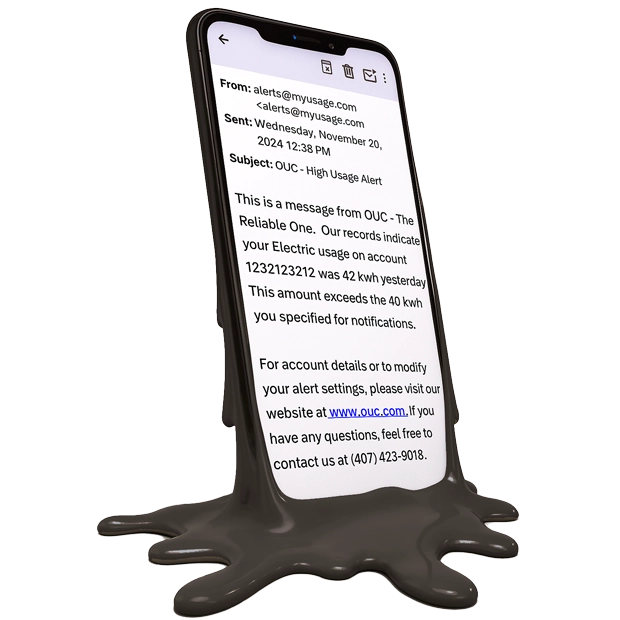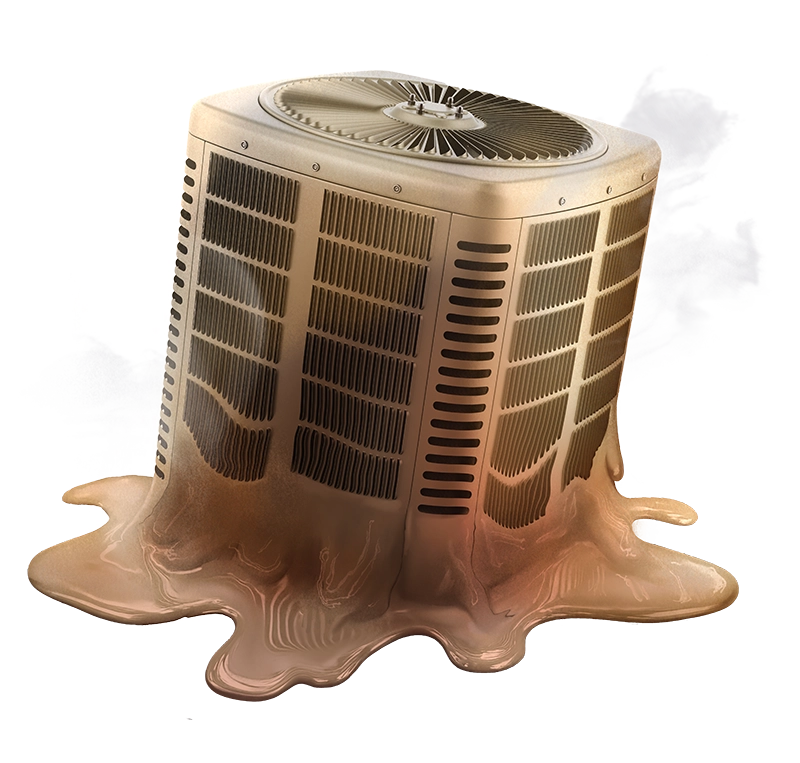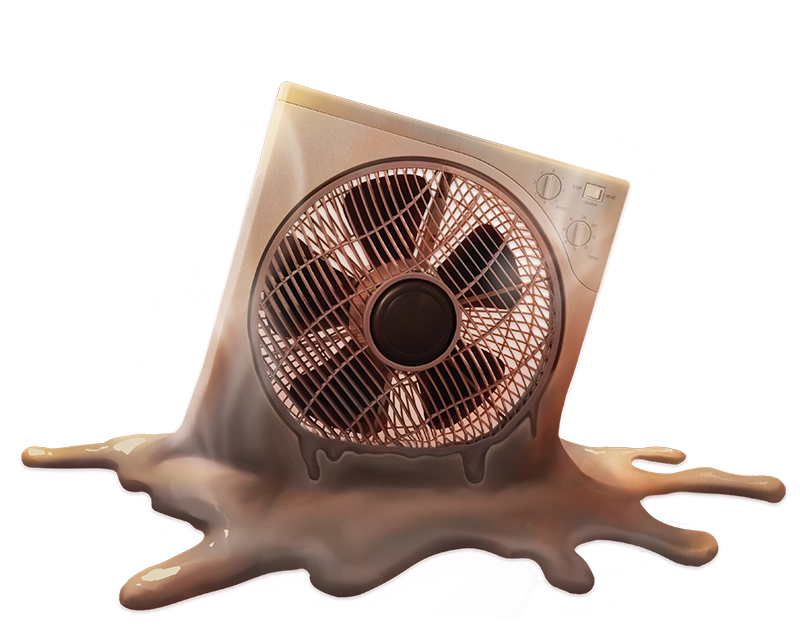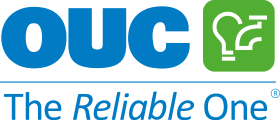Get Summer-Ready
Here are three ways to survive Florida Hot without sweating your budget.
Usage Alerts
Track your usage to stay ahead of surprises.
Budget Billing
Fixed monthly bills for easier budgeting.
Energy-Saving Tips
Feel the difference and see the savings when the heat is on.
Stay Alert & In Control

Avoid unexpectedly high bills by setting up high usage alerts. Visit your Usage Dashboard in myOUC to set up an alert when your daily electric consumption exceeds a set threshold.
How It Works:
- Set your preferred usage threshold.
- Get an email alert the next day if your usage exceeds that threshold.
- Review the Usage Dashboard to see your hourly use.
- Investigate the devices or appliances that were on during those times to see if there is an opportunity to be more efficient.
5 Easy Steps to Enroll in Usage Dashboard Alerts
Step 1: Access the Usage Dashboard
Log in to your myOUC account and click on the “View Usage” button just below your billing summary. Make sure you have pop-ups enabled on your browser.
To view the Usage Dashboard, you must be an OUC residential electric customer.
Step 2: Note Your Average Usage
Make a note of your “Avg Energy Use” on the summary page. You’ll need this number when setting up your High Usage Alert, so be sure to write it down.
“Avg Energy Use” is your average daily usage over the past month, or how many kilowatt-hours (kWh) you use each day, on average.
Step 3: Add Your Email Address
Click on the settings tab and then click on the blue button labeled “Configure Contact Methods” to add your email address.
You can add up to six email addresses, so be sure to give each entry a unique name. For example, you might want to add both your email and your spouse’s email.
Step 4: Create an Alert
Click on the blue button labeled “Create Alert” to get started. You’ll notice a field labeled ‘Usage Threshold,’ where you can enter any value you want. This is where your average energy usage comes into play.
A good starting usage threshold may be 20% more than your average usage. To find out what that value is, multiply your average usage by 1.2. For example, if your average energy usage is 40 kWh, your usage threshold would be 48 kWh.
If your energy bill has been high, you might want to set a lower threshold. The good news is you can adjust this value at any time!
Step 5: Check Your Inbox
If your energy use goes over the threshold, you’ll receive an email from OUC the next day. This is a reminder to revisit the Usage Dashboard, review your energy consumption and see if there is an opportunity to be more efficient.
Pro-Tip: If your usage is consistent throughout the day, consider looking at devices that run all day long—such as A/C units—especially if no one is home during those times.
Eliminate Summer Bill Spikes
Fixed monthly bills = easier planning. If your bill is sweating during the summer, try OUC’s free Budget Billing service. It evens out your utility bills and eliminates seasonal ups and downs.
Why It Works:
- Keeps your bill at a fixed dollar amount for 12 months*, making it easier for you to plan and balance your monthly budget.
- You’ll know exactly how much to budget for your utilities each month, helping you avoid unexpected spikes in your bills.
- Enrollment starts by logging in to your myOUC account and completing the Budget Billing enrollment form.

Annual Adjustment
Your monthly Budget Billing amount is based on your average monthly bill for the past 12 months. An additional percentage at the discretion of OUC will be added to the amount to prevent the deferred balance from growing too large.
*If your actual usage significantly deviates from the budgeted amount (exceeds a 20% difference), the monthly budget amount may be recalculated before the 12-month period ends.
Detailed Billing
Each month, your electric and/or water meter will be read, and the amount of energy and water used will be reflected on your bill.
You will also see the Budget Billing amount and any variance between your actual bill and the Budget Billing amount. This transparency helps you track your usage and budget effectively.
Play Offense & Beat the Heat
Your A/C is working overtime in the summer. But you can minimize the impact of hot weather with these energy-saving tips:

Give Your A/C a Helping Hand:
- Keep your A/C set to “auto” so the fan is only running when necessary.
- Replace dirty or clogged A/C filters. Dust and debris restrict airflow, forcing your A/C to work harder.
- Make the switch to a smart thermostat that can raise the temperature when you’re away and cool things down just before you come home.
- Try setting your thermostat to 78°F or higher. For each degree below 78, your cooling costs can increase by 6–8%. If 78°F feels too warm, take the “one-degree challenge” and gradually raise your usual setting one degree at a time.
Need a new Heat Pump A/C? There’s a rebate for that: ouc.com/rebates
Let Fans & Shades Do the Work:
- Ceiling fans create a wind chill effect, making your space feel a few degrees cooler without having to adjust your thermostat.
- Use shades, drapes, blinds and window film to keep the sun and heat out—especially on windows facing east or west.
- Close windows and outside doors to keep cool air inside.
Want to get started with window film? There’s a rebate for that: ouc.com/rebates


Clean Without the Steam:
- Have a dishwasher or washing machine? Only run full loads and avoid using hot water. Water heating can account for 14% to 25% of the energy consumed in your home.
- Check your water heater temperature to ensure it’s set no higher than 125°, otherwise you’re wasting energy.
- Air dry clothing when possible. Take advantage of natural (and free) drying power. Don’t overload the dryer as overloading blocks airflow and makes drying inefficient.
Looking to cut hot water costs? There’s a rebate for that: ouc.com/rebates
Heat Got You in a Pinch?
We understand that summer bills can be tough. These financial assistance programs can help.
City & County Energy Assistance
The Low Income Home Energy Assistance Program (LIHEAP) and Emergency Home Assistance for the Elderly Program (EHEAP) can help you prevent disconnection or restore electric service.
Financial Assistance with Project CARE
Project CARE has helped thousands of local families keep their lights on and the water flowing when they need it most.

